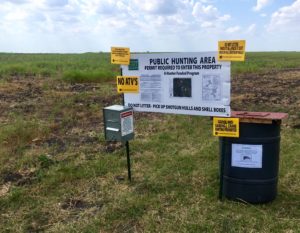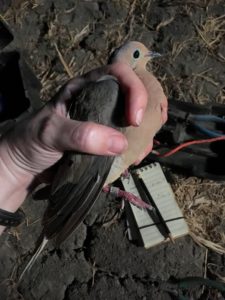This week I did some work on the chisel plow and getting in the field to break through the hard pan in the soil. I got to do some welding and grinding to fix the plow too.
Thanks and Gig’em,
Michael Escobar
Week 14:
Hunting season started off with a bang on September 1st (please pardon the obligatory pun), and I’ve since been busy collecting wings from the barrels in order to record harvest data. As of last Friday, we have documented over 175 doves harvested from the farm so far this season, so quite a bit of activity for the first week. Adult mourning doves have accounted for approximately 59% of birds harvested, with juvenile mourning doves making up another 24% and all white-winged doves and Eurasian collared doves coming in at 11% and 6%, respectively. I am interested to see if those percentages change over time as the season progresses.
Coverboard deployment was pushed back a week due to some adjustments I made to the lifts after constructing a test coverboard with the original lengths, which did not leave as wide an opening as I had envisioned. I spent some time last week shortening the lifts and trimming them at an angle in order to further encourage herps that might be moving along the outer e dge to flow into the opening and under the board. I began distributing the boards on Monday and should finish setting everything up by tomorrow. The included photo shows the underside of the final design for the lifted coverboard.
dge to flow into the opening and under the board. I began distributing the boards on Monday and should finish setting everything up by tomorrow. The included photo shows the underside of the final design for the lifted coverboard.
Last week’s interesting wildlife sightings included a juvenile Western ratsnake (Pantherophis obsoletus) who had the misfortune to get caught in a glue trap inside a house (it was rescued and released), as well as a female Io moth (Automeris io) found resting on the office door one morning and a Carolina mantis (Stagmomantis carolina) enjoying her lunch of filleted dragonfly. Side note: If you find an animal in a glue or sticky trap that you wish to release, try spraying non-stick cooking spray on and around where it is stuck to the trap, avoiding the head as much as possible, before attempting to gently peel the animal off the trap. Liberal application of olive oil or a similar product can also help the process along, and will help remove the glue from your hands as well.
Dani Miller
Wildlife Biologist
Stiles Farm Foundation
Weeks 12 & 13:
Last week, I was provided a second lesson driving the tractor with the shredder attached, with the purpose of shredding 3 initial strips in a pasture as preparation for dove hunting season. I will be shredding more strips at intervals in various pastures throughout the hunting season to continue putting seed on the ground from naturally-growing forbs. Yesterday, I set out wing barrels at each of the 4 entry points to the public hunting areas of the farm, near the TPWD registration billboards. Once the season begins, I will be collecting wings once or twice per day and recording the data on species, quantities, and ages of birds harvested.
Regarding the coverboard project, all of the roofing tin sheets are ready to go. I have a few more plywood boards to cut down, and will be adding 1” lifts to 1 of the 2 plywood coverboards at each site, in order to see if this adjustment leads to an increased capture rate compared to the adjacent board lying flush with the ground. I plan to begin deploying the coverboards next week, 2 tin and 2 plywood, to each of the 16 sites, and will start checking them once they have had time to settle, likely in 2-3 weeks.
I finished spraying mesquite in the project area this morning. The next step on that front will probably take place in October and involve marking larger trees not covered by the aerial spray in order to target them for cut-stumping this winter. Upcoming projects in September include small mammal trapping along established transect lines and camera trapping at the start points for said transects, as well as raptor surveys and waterfowl pond surveys. I plan to experiment with cameras at the ponds in order to see if that can increase my accuracy determining waterfowl species and numbers present, as compared to concurrent visual surveys at dawn.
 I have included photos of a male and female painted bunting recently spotted on the bridge over the creek on the south side of the farm. My piles of coverboard materials and the sight that will greet dove hunters at access points this weekend round out the eye-catchers for this post.
I have included photos of a male and female painted bunting recently spotted on the bridge over the creek on the south side of the farm. My piles of coverboard materials and the sight that will greet dove hunters at access points this weekend round out the eye-catchers for this post.
Happy hunting,
Dani Miller
Wildlife Biologist
Stiles Farm Foundation
Dove banding season is now over. The tally for this year is 19 banded mourning doves and 1 white-winged dove. I had hoped to deploy all the mourning dove bands provided by TPWD this season, but at the very least, I now feel competent in the banding process for dove-sized birds, which was a significant objective of the project for me. Today, I will be collecting and storing the traps and sweeping away any remaining bait at the sites in anticipation of the upcoming hunting season. My next dove-related tasks will involve shredding strips in public hunting pastures that have dove-friendly, seed-bearing forbs such as sunflowers and volunteer sesame, in order to provide ideal habitat for birds and consequently, optimize hunting opportunities during the season.
This past Wednesday, I collected north, east, south, and west-facing photo points at each of the 14 sites around the farm, the locations of which were previously established by my predecessor, AnMarie. This visual data allows us to observe changes in the landscape and vegetation communities over time, and the task had the added benefit of familiarizing me with the location of each site. This will make it a smoother process when I conduct vegetation surveys soon, as the sites also act as starting points for established transect lines.
In other news, I have 22 of my 32 plywood herp coverboards cut and ready to go, and the roofing tin is on the docket to be cut down next week. I can report that mesquite spraying is still a work in progress, but the evidence of control coverage has been satisfying to observe. Please enjoy these photos from Wednesday of a friendly neighborhood gopher snake (Pituophis catenifer) and a southern black widow (Latrodectus mactans), as well as a buddy of mine that regularly hangs out near one of my dove traps, this common nighthawk (Chordeiles minor) whom I have dubbed Waldo for obvious reasons. Weeks 10 & 11
Until next time,
Dani Miller
Wildlife Biologist
Stiles Farm Foundation
My success trapping doves has increased significantly, with most of the activity isolated to a line of 3 traps set along a dirt road which runs between a mature corn field on one side and a pasture on the other. After starting with 23 mourning dove bands at the beginning of the season (July 1), I have 7 left to deploy between now and August 15, and I am reasonably confident that this objective can be achieved. I had thought I was going to reach the end without trapping a single white-winged dove, as they have been rather scarce at the farm this season, so I was quite surprised when I caught one yesterday. I don’t expect a surplus of the species in the final week of banding, but I will remain prepared nonetheless.

This week into next, I am focusing on spraying mesquite in the morning and trapping doves in the evening, as both need to be completed sooner rather than later and those times of day are respectively ideal for each undertaking. This also allows me a reprieve from the heat in the middle of the day, when I take a break and then focus on indoor tasks, such as researching study methods, vegetation identification, and writing these posts.
The herp coverboard project should be moving forward as of tomorrow, when I plan to begin cutting down the salvaged plywood and tin materials into appropriately-sized boards. This task will require much-needed training and practice in the safe handling and use of various saws as provided by Dr. Tomeček, which will also be helpful in an upcoming project involving the construction of a set of doors to replace an old pair for our store room. I have assisted my dad with carpentry projects in the past and have an understanding of the basics, but this will be the first job that I plan and follow through from start to finish. I look forward to gaining a few new skills with both this and the coverboard endeavor.
Dani Miller
Wildlife Biologist
Stiles Farm Foundation
Week 9
Final blog
Overall, I believe this internship was a great experience and I was extremely lucky to be a part of the Stiles Farm team in Thrall, Texas. Everything I have learned from this internship I will carry with me as I pursue my career in the field of Horticulture. I am grateful for the privilege to meet important people in my field of study and learn tips and lessons that will help me in the real world as I develop my own business interests. I will truly miss stiles farm; waking up to the sunset, taking care of the cattle, working on equipment and developing my own landscapes that I will be able to put in my portfolio. I tried to make the most out of this internship, ask as many questions as I could and provide my own input when needed. I feel that this internship involves a lot of self-discipline and craftmanship and that’s exactly what I brought to the table.
